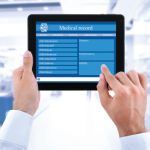Another challenge (or opportunity for billing) is that the EHR has the ability to compel more thorough documentation; paper records have been subject to tremendous user variability, at times characterized more by brevity and superficiality than completeness and relevance. Clinical decision support, the exclusive domain of the EHR, may remain the greatest disappointment in modern EHRs—the promise of its fulfillment still tantalizing many.
Lawrence Reed initiated a movement in the 1970s to standardize clinical documentation in the paper record. His legacy is still apparent in the frequent use of the assessment and plan portion of contemporary EHRs. But the classic Weed SOAP note, consisting of the subjective, objective, assessment and plan, is rarely used. There is also a growing disparity between inpatient and outpatient documentation in its depth and comprehensiveness. Added to this is the automated addition of largely normal laboratory, radiographic and other prior information, which has led to bloated notes, in which it can be difficult if not impossible to understand precisely what the clinician is thinking about the patient’s problem, what interventions might be planned or why.
Contemporary EHRs increasingly have sacrificed narrative for succinct and standardized vocabulary. Traditionally, the history of the present illness was the patient’s story as he or she experienced it, at times modestly edited by the clinician for relevance. Similarly, the assessment and plan were the clinician’s story, relating his understanding of the clinical problem and his plans for addressing it. Both of these at their best are stories, with all of the richness of vocabulary and nuance of expression of the individuals involved.

Increasingly, clinicians find it difficult to allocate sufficient time for detailed documentation of clinical activity. Drop-down fields have improved efficiency, while sacrificing the richness of vocabulary apparent in the well-crafted narrative. This has led to potentially dangerous difficulties in communication between clinicians; the medical record has increasingly bowed to the needs of documentation for billing, with the sacrifice of clarity and weighting of relevance in the characteristics of clinical care and the planned course of action.
A number of opportunities exist that would greatly enhance clinical communication, as well as recognize the tremendous demands on clinician time and energy.
Voice recognition is becoming a mature technology that affords much greater efficiency and clarity in the input of the clinical narrative. One product even has the capacity to use natural language-processing techniques for real-time data extraction, potentially fulfilling multiple demands with the same tool. Typing, or keyboarding as it is more commonly described, has the capacity for fairly rapid input if sufficient skills have been acquired by the clinician. Both of these tools have the capacity to return to the clinician the richness of vocabulary and thought that is slipping away in contemporary EHRs, at the cost of increased demand on time. Patient-entered information also has great potential, if technologies can be developed to refine both relevance and accuracy. Improved structured data input constrained by predefined fields of information has the potential for tremendous benefit, although it will likely always lack the richness of narrative vocabulary.

